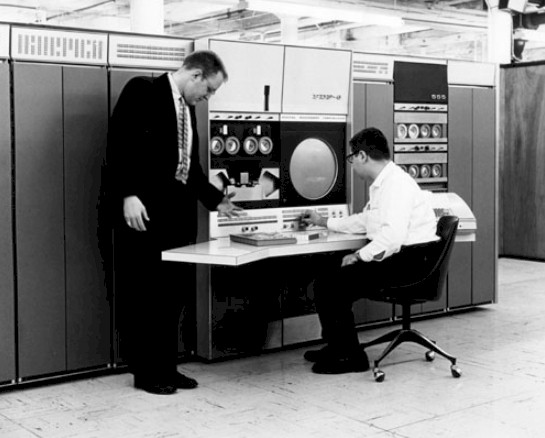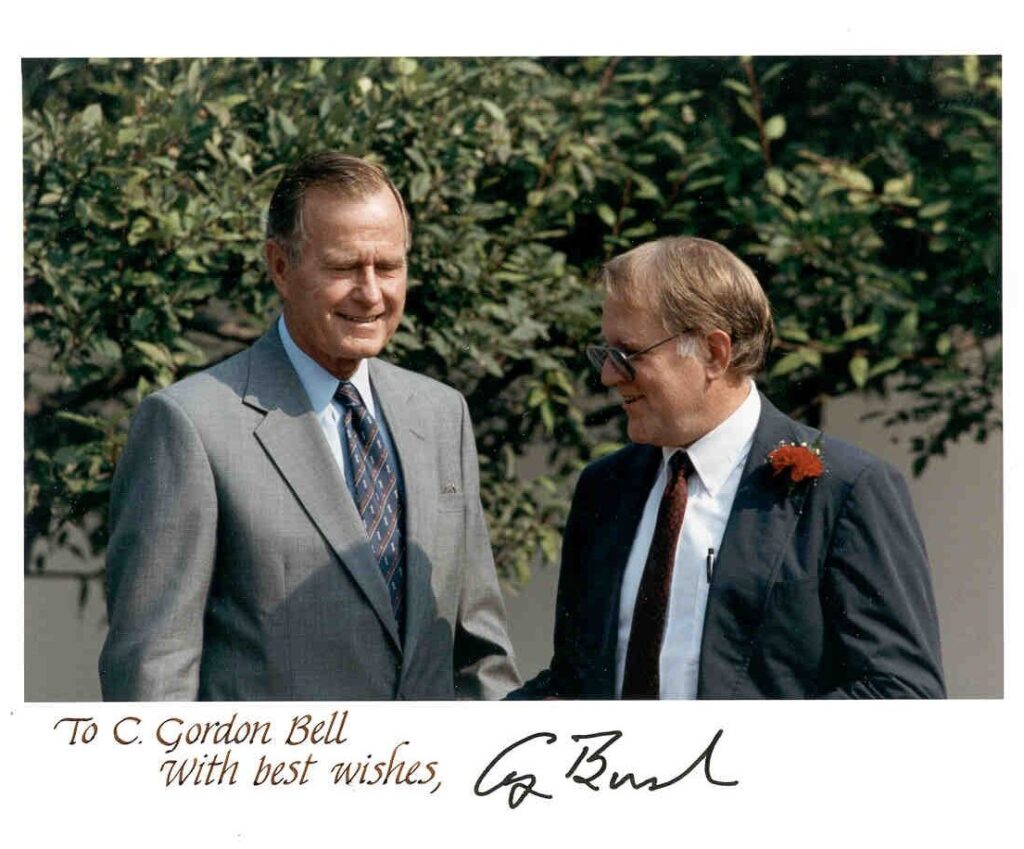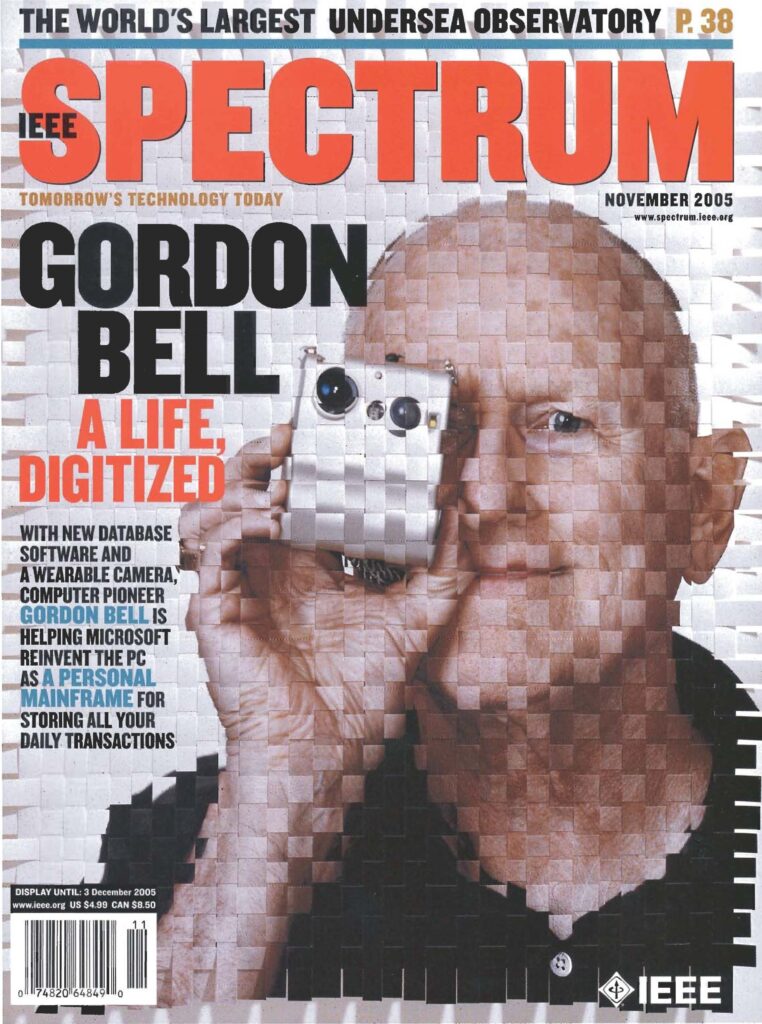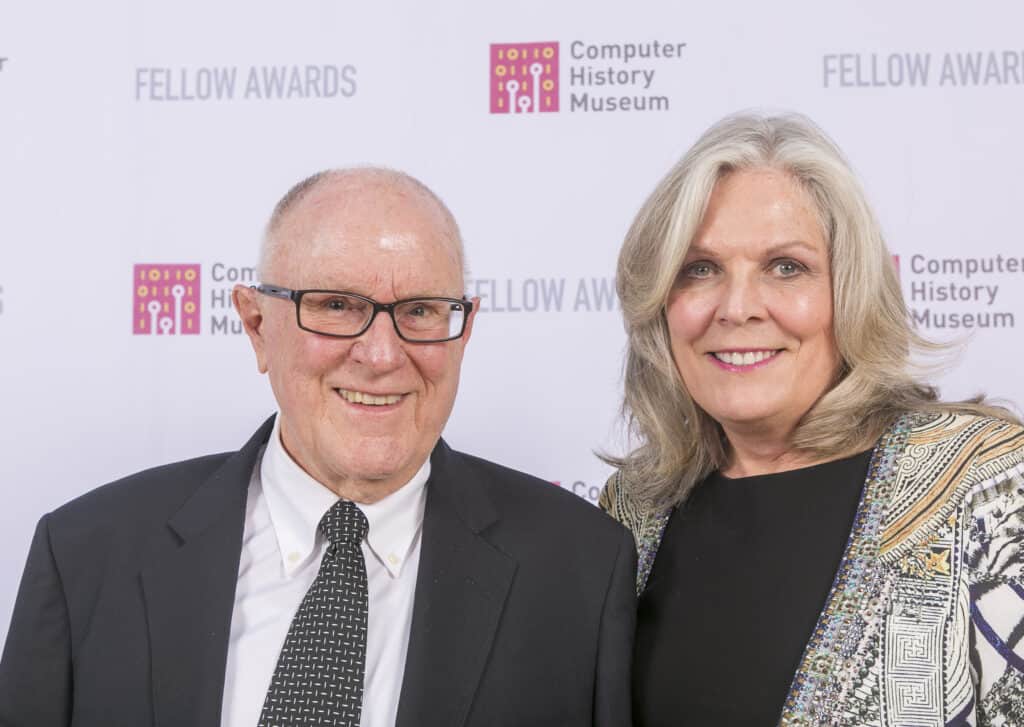
Chester Gordon Bell was born in Kirksville, Missouri on August 19, 1934, and was named after both his father, Chester Bell, an electrician and appliance repairman, and Lola Gordon Bell, a grade schoolteacher. Bell gained experience working with electricity at an early age, wiring houses and repairing appliances for the family business, Bell Electric. Hard work and a passion for science experiments and puzzles led him to attend the Massachusetts Institute of Technology (MIT), where he earned his Bachelor of Science and Master of Science degrees in Electrical Engineering. While at MIT, Bell worked with pioneers of computing Jay Forrester and Ken Olsen—all three would become CHM Fellows.
In 1958, Bell was a Fulbright Scholar at the University of New South Wales in Australia, where he taught computer systems design and proposed to his bride-to-be, Gwen, via an English Electric DEUCE computer, a computer designed after the Pilot ACE of Alan Turing.
In 1960, Olsen and colleague Harlan Anderson recruited Bell to their new company, Digital Equipment Corporation (DEC). DEC was instrumental in the development of minicomputers—a new class of computer they defined—and Bell quickly became a pivotal figure in the company's growth through his technical skills and engineering leadership.
Bell's first major project at DEC was the PDP-1 (Programmed Data Processor-1), one of the earliest minicomputers. The PDP-1 was revolutionary for its time, a powerful yet relatively affordable computer for which Bell designed the I/O subsystem (and invented the UART). Bell's work on the PDP-1 laid the foundation for the subsequent PDP computer series, including the wildly successful PDP-8 (1965) and PDP-11 (1970) models.

Gordon was respected for both his technical and engineering leadership skills at DEC and Microsoft. Bell (left) at the PDP-6, Digital Equipment Corporation, 1964.
From 1966-72, on leave from Digital, Bell was Professor of Computer Science and Electrical Engineering at Carnegie-Mellon University. He and Allen Newell coauthored Computer Structures (1971), rewritten in 1982 with Dan Siewiorek. The book was an ambitious attempt to compare computer architectures of the time using a specialized taxonomy they had developed and was widely used in universities.
In 1972, Bell returned to Digital as vice president of research and development, and led the development of DEC's VAX (1975-1978) family of minicomputers—models of which defined technical computing for the next decade around the world, from small laboratories to large multi-user university departments. In spite of DEC’s promotion of its in-house VMS operating system, it was upon VAX computers that the competing Unix system evolved. In part because of this, the VAX family was arguably the most important group of computer systems of its time—for both the growth of the internet and for academic computer science in universities to flourish. Bell was also instrumental in the promotion of Ethernet as a standard for local area networks, along with Intel and Xerox, a key milestone in its acceptance (as was establishment of the IEEE 802 working group).
With Ken Olsen and then-wife Gwen, Bell cofounded the Digital Computer Museum in Marlborough, MA (1979); becoming The Computer Museum, Boston, MA (1984); and, with cofounder networking entrepreneur Len Shustek, The Computer Museum History Center, Mountain View, CA (1996), and finally, the Computer History Museum (1999). (We write now from the mighty oak which has grown from the acorn these three visionaries planted that day). Since its founding, Gwen and Gordon Bell were very generous donors and supporters of the Museum and have attracted other generous supporters as well through their network of personal contacts.

Gordon understood before many that the technology revolution needed to be preserved. The Computer Museum, Boston was cofounded by Bell in 1979.
Bell left DEC again in 1983 after suffering a heart attack in March of that year. Upon recovery, he later cofounded supercomputer startups Encore Computer, Ardent (1986) and Stardent (1989). The goal at Encore Computer and its follow-on companies was to build computers with supercomputer-level performance and visualization at lower cost by using off-the-shelf components.
In the 1980s, Bell became involved with the National Science Foundation to help drive its investments in supercomputing and in 1987 established the Gordon Bell Prize in conjunction with the Association of Computing Machinery to drive innovation in parallel processing—a Prize that remains highly sought after by the high-performance computing community.
In recognition of his efforts, in 1991, President George H.W. Bush awarded Bell the National Medal of Technology "for his continuing intellectual and industrial achievements in the field of computer design; and for his leading role in establishing cost-effective, powerful computers which serve as a significant tool for engineering, science, and industry."

Gordon was awarded the National Medal of Technology by President George W. Bush in 1991.
In the 1990s, Bell was instrumental in convincing Microsoft to establish a research arm and he joined Microsoft Research from 1995 to 2012, working on various projects including his daily "life-logging" application, MyLifeBits.

Gordon pioneered wearable technology with his passion for "lifelogging." Shown here with his wearable camera on the cover of IEEE Spectrum, 2005.
In 2003, Bell was named a Computer History Museum Fellow, “For his key role in the minicomputer revolution, and for contributions as a computer architect and entrepreneur.”
Gordon Bell accepts his 2003 Fellow Award.

Gordon was a founding trustee of the Computer History Museum in Mountain View. Shown here with his wife Sheridan Sinclaire-Bell, at the CHM Fellows Awards, 2019. Bell was made a CHM Fellow in 2003.
Bell could think at the micro and macro scales with ease. After decades of observation, he proposed this eponymous law: “Roughly every decade a new, lower priced computer class forms based on a new programming platform, network, and interface resulting in new usage and the establishment of a new industry.” This is an observation-based conclusion, using the history of computing as its lodestar: mainframes, minicomputers, microcomputers, smartphones, the Cloud . . . are chapters in Bell’s “book” of computer classes.
Datamation magazine called Bell, “the Frank Lloyd Wright” of computing. As an architect for five decades of computing systems, he not only witnessed but personally shaped our civilization’s transition from room-sized mainframe computers to the personal computer and beyond—making this "most incredible invention of the 20th century" as Bell called the computer—smaller, more interactive, affordable—and ubiquitous. Gordon was like a meteor, beginning life in rural Missouri and streaking across our skies with ideas, enthusiasm, and energy.
With heavy but grateful hearts we say, "Farewell, Gordon. It has been the honor of a lifetime to share in your remarkable life."
Gordon Bell passed away on May 17, 2024. He is survived by his first wife, Gwen, and his second wife, Sheridan Sinclaire-Bell, whom he married in 2009; his son, Brigham, and his daughter, Laura Bell, both from his first marriage; his stepdaughter, Logan Forbes; his sister, Sharon Smith; and four grandchildren.
Below, members of the CHM community remember Gordon.
I am so sorry to hear this news. Gordon was such a force of nature that it seemed like he would go on forever. I knew him first by reputation when I was a computer science student in the 60's. I've known him in person from the day in 1995 that he showed up in my office to talk about the computer museum I wanted to start and said "I have a deal for you." He did, and it worked. Gordon was brilliant. He was opinionated. He wasn't always consistent, but he was always passionate. He made things happen, and the world is better for it. He will be missed by many, including me.
Gordon was a friend, colleague, and mentor. He established his prize, initially set at $1,000, for the best speedup of a real application running on a real machine. The first year's prize was awarded to the entrant who demonstrated the highest speedup. Subsequent winners had to double the previous winner’s speedup until either the speedup reached 200 times that of the sequential application or 10 years had passed—whichever came first. Today, the Bell Prize is highly sought after. Gordon was a special person in many ways. His work and our memory of him will be with us for a long time, and his presence will be sorely missed.
I had the opportunity to interact a lot with Gordon through some of the early years at CHM. I always found him to be an inspirational and original thinker. Gordon was one of those people where I leaned in when he was talking. I knew that something fresh, interesting, and unexpected would come forth.
I can't adequately describe how much I loved Gordon and respected what he did for the industry. As a kid I first ran into him at Digital (I was then at DG) when he and Dave were working on VAX. So brilliant, so calm, so very upbeat and optimistic about what the future might hold. The number of times Gordon and I met while at Microsoft—acting as a sounding board, helping me through challenges I was facing is uncountable. Gordon, I and we will miss you. Thank you for what you gave to each of us, and to all. You were one of my heroes.
Gordon Bell had an innate sense of what computers could be and should be. He was not only a pioneer in computing, but the creator of other pioneers through the challenges he set forth. I know of no other person in computing who has done so much to help the careers of others, while also advancing the industry.
Gordon changed my life. In 1975, Gordon had the generosity and grace to arrange for a pimpled-faced 15 year-old to purchase a PDP-8. That teenager was me and that PDP-8 was the starting point of what became a 50-year career in software development. I don’t believe a day has gone by when I am not thinking about or writing software—a direct result of Gordon’s generosity. As luck would have it, in 2000, I was given the chance to return some of my good fortune to Gordon through the Computer History Museum by helping to fund the move of Gordon’s collection of DEC artifacts to its permanent home on the West Coast. Gordon’s contributions to the industry are legendary but I will never forget how he transformed my own small life. I will miss him dearly.